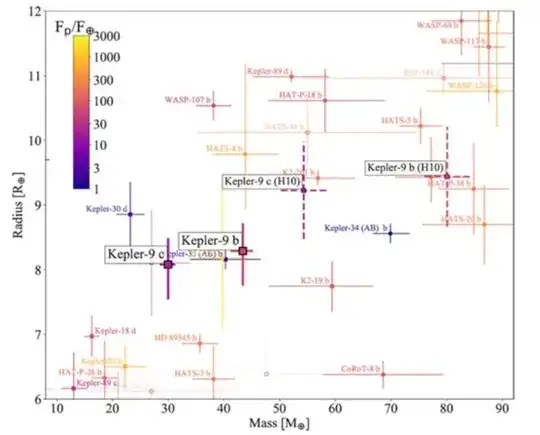An exoplanet with density 0.31 grams per cubic centimeter has been found. Is this the least dense exoplanet we know of?
-
1See https://astronomy.stackexchange.com/questions/13382/planets-classification-by-density?r=SearchResults – ProfRob Nov 19 '19 at 22:17
-
1And pretty much a duplicate of https://astronomy.stackexchange.com/questions/8440/maximum-and-minimum-gas-giant-ice-giant-densities/8444?r=SearchResults#8444 – ProfRob Nov 19 '19 at 22:21
1 Answers
The article you link to refers to Borsato et al. 2019, which attempted to rectify discrepancies in the measured properties of planets in the Kepler-9 system between transit timing variation measurements and radial velocity measurements. They arrived at $\rho\sim0.31^{+0.05}_{-0.06}\text{ g cm}^{-3}$ for Kepler-9c. However, Borsato et al.'s Figure 10 shows that there are other exoplanets in this mass regime with substantially lower densities, e.g. WASP-107b, which comes in at about $\rho\sim0.19\text{ g cm}^{-3}$:
Even WASP-107b, however, doesn't hold the record for the least dense exoplanet. The three planets in the Kepler-51 system, Kepler-51b, Kepler-51c, and Kepler-51d, may hold that record. Multiple groups (Masuda 2014, Roberts et al.) have found densities of around $\rho\sim0.03\text{ - }0.06\text{ g cm}^{-3}$ for both planets.
- 36,553
- 3
- 123
- 201
-
Just a thought: Would an alternative version of the diagram that is often shown with the lines of constant density corresponding to particular bulk densities (e.g. this one) better illustrate the point ? – astrosnapper Nov 19 '19 at 18:57
-
Or a plot of density Vs mass for transiting exoplanets. Such as the one I constructed to answer https://astronomy.stackexchange.com/questions/13382/planets-classification-by-density?r=SearchResults – ProfRob Nov 19 '19 at 22:14
